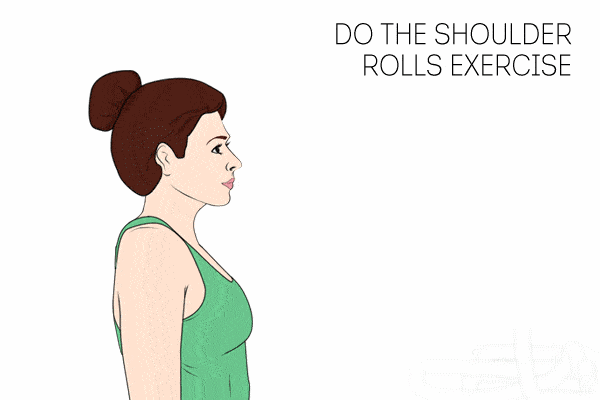Sitting or standing at your desk all day does not look like hard work, but it can be very physically demanding for your body. This can lead to neck and shoulder pain.
It is very common for chronic shoulder pain to develop due to prolonged, repetitive or awkward movements. When you’re doing small, repetitive activities, it can strain the muscles and tendons of your upper body. This can lead to a gradual development of shoulder pain rather than it hitting you all at once.
Other causes of work-related shoulder pain include awkward postures, using a computer mouse, working with your arms above the shoulder level, force or pressure on your shoulders (even in small amounts), mechanical contact stress, static loading, hand-arm vibration, full-body vibration and extreme temperature exposure.
Moreover, a sedentary work environment and work habits can weaken your muscles and set the stage for pain.
A study published in Occupational and Environmental Medicine in 2002 found that both physical and psychosocial exposures in the work environment were associated with neck or shoulder pain. Among women, such pain was linked to an increased amount of visual display terminal work, work above the shoulder level and reduced opportunities to acquire new knowledge. Among men, an increased amount of seated work was associated with such pain.
Another study published in the International Journal of Preventive Medicine in 2014 found that pain expectation and a somatization tendency to either report or worry about common somatic or nonmusculoskeletal symptoms are risk factors associated with persistent neck/shoulder pain among computer operators. This confirmed some other similar studies on work-related musculoskeletal disorders in European countries in recent years.
Later in 2016, a study published in BMJ Open concluded that in blue-collar workers, more sitting time at work was associated with a favorable development of neck-shoulder pain intensity over time.
No matter what’s causing your shoulder pain, you need to take the issue seriously or the pain will go on increasing day by day. This can affect your work and even day-to-day activities. Before the pain becomes unbearable, take steps today to reduce it.
With little changes here and there, you can prevent or reduce shoulder pain at work effectively.
Here are the top 10 tips to prevent work-related shoulder pain.
1. Sit Correctly
When you spend most of the time sitting at your desk, it’s important to sit correctly. The right posture will help a lot in reducing pressure on your shoulder and neck area, thus preventing shoulder pain.
To maintain the correct sitting posture:
- Your feet should be planted firmly and flat on the floor or a stable footrest.
- Your thighs should be parallel to the ground.
- Your lower back should have good support.
- Your elbows should be supported and close to your body.
- Your wrists and hands should be in line with your forearms.
- Your shoulders should be relaxed.
Make sure you do not slouch while sitting all day at your desk. It’s a common problem among desk jockeys and will only put more strain on your upper body.
2. Change Positions Frequently
When working in the office, you must try to change your position every couple of hours. Staying in the same position for a long period of time can cause strain on your neck, back, and shoulders.
If you’ve been sitting for an hour, then take a break and do some work while standing. You can also walk around for a few minutes. The idea is to alter your position frequently to add variety.
At the same time, avoid slouching, leaning in awkward positions and rounding your shoulders, which all could lead to discomfort and pain.
3. Rearrange Your Workspace
The position of your monitor, keyboard, mouse, and even the chair you are using can have a hand in causing shoulder pain.
Your desk should be level with your elbows while you’re seated. It should not be too high, as it can cause shoulder fatigue. Also, if it is too low, it can lead to slouching.
The computer monitor should be placed about an arm’s length away from you. The top of your screen should be just below your eye level. For your keyboard and mouse, consider installing an adjustable keyboard and mouse tray.
Since you spend several hours in your desk chair, use one that provides full support to your back and shoulders. The chair should have a solid cushion to sit on, good lower back support and an adjustable height feature so that you can set it so your feet are comfortably on the floor.
4. Use a Sit-Stand Desk
To improve your posture and reduce shoulder pain, investing in a sit-stand desk is highly recommended. Standing improves core strength, which in turn improves posture.
When your desk is in the standing position, your computer screen should be just above your resting eye level, so you do not have to hunch over or slouch to work on your computer.
A 2009 study published in Human Factors: The Journal of the Human Factors and Ergonomics Society reports that implementing a sit-stand workstation paradigm can be an effective workplace health intervention to reduce musculoskeletal complaints (4).
Installing a sit-stand desk is easy, and in fact, many workplaces already offer this option to their employees. Check with your human resources department to find out if it is available to you.
5. Take Regular Breaks
Sitting all day in front of your computer is not good for your overall health, including your shoulders. The sitting position puts more pressure on the spine, which can result in chronic shoulder pain.
Prolonged sitting causes damage to the muscles, bones, tendons, and ligaments, affecting the neck, shoulders and lower back regions. Plus, prolonged sitting can make your muscles more likely to pull or strain when stretched suddenly.
Experts recommend taking a 5-minute break for every 30 minutes of sitting in front of your computer. During each break, shake out your hands and arms. Close your eyes and relax your whole body for a bit.
Every once in a while, leave your desk and take a walk. A 10-minute walking break every 2 to 3 hours can significantly help reduce pressure on your neck and shoulder area.
6. Do the Shoulder Rolls Exercise
Exercise can help prevent shoulder pain associated with long hours of sitting. In fact, there are many easy and quick shoulder stretches that you can do at work, even while sitting in your chair.
One such shoulder-stretching exercise is shoulder rolls.
- Keep your back straight and your chin tucked in.
- Roll your shoulders forward, up, back and down in a circular motion.
- Repeat 10 times, then reverse the direction.
- Do it 3 or 4 times a day.










